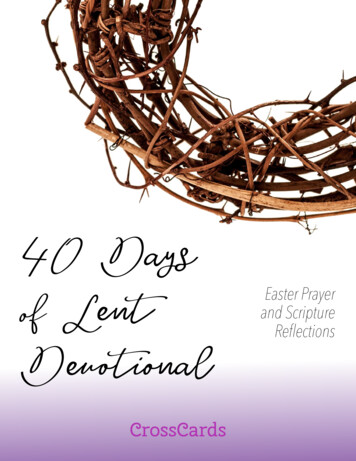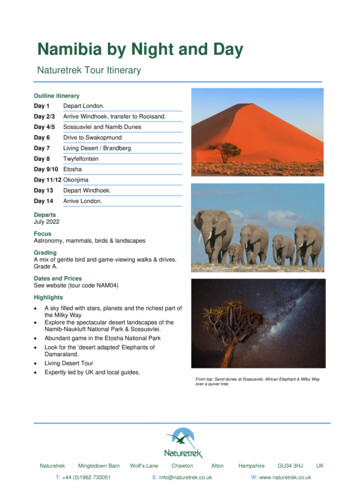
Transcription
Namibia by Night and DayNaturetrek Tour ItineraryOutline itineraryDay 1Depart London.Day 2/3Arrive Windhoek, transfer to Rooisand.Day 4/5Sossusvlei and Namib DunesDay 6Drive to SwakopmundDay 7Living Desert / BrandbergDay 8TwyfelfonteinDay 9/10 EtoshaDay 11/12 OkonjimaDay 13Depart Windhoek.Day 14Arrive London.DepartsJuly 2022FocusAstronomy, mammals, birds & landscapesGradingA mix of gentle bird and game-viewing walks & drives.Grade A.Dates and PricesSee website (tour code NAM04)Highlights A sky filled with stars, planets and the richest part ofthe Milky WayExplore the spectacular desert landscapes of theNamib-Naukluft National Park & Sossusvlei. Abundant game in the Etosha National Park Look for the 'desert adapted' Elephants ofDamaraland. Living Desert Tour Expertly led by UK and local guides.Böhm's Bee-eaterFrom top: Sand dunes at Sossusvlei, African Elephant & Milky Wayover a quiver tree.NaturetrekMingledown BarnT: 44 (0)1962 733051Wolf’s LaneChawtonAltonE: info@naturetrek.co.ukHampshireGU34 3HJW: www.naturetrek.co.ukUK
Tour ItineraryNB. Please note that the itinerary below offers our planned programme of excursions. However, adverseweather and other local considerations can necessitate some re-ordering of the programme during thecourse of the tour, though this will always be done to maximise best use of the time and weatherconditions available.Day 1In flightWe depart London in the afternoon on an overnight flight to Windhoek.Day 2/3Rooisand Desert RanchArriving in Windhoek, Namibia's modern capital in the early afternoon we will be met by our local Namibian guideat the airport and head off on the three-hour drive to the Rooisand Desert Ranch. Here on our first night (forthose not too tired from the flight) we will acquaint ourselves with the southern constellations. Many of the starsseen from this southerly latitude cannot be seen from the UK and even those that do see in the UK appear at adifferent angle so it takes a little time to get your eye in and start to become acquainted with them. On the firstevening the major features in the sky will be pointed out and a pair of wide-field binoculars will be used to seethem in great detail. On the second night the wonders of the sky will be observed using the telescopes that arepermanently mounted on a site set away from the accommodation. The observatory houses two refractorsmounted piggyback on a 17” reflector telescope.Rooisand Desert Ranch is situated on the fringe of the Namib Desert in Namibia's Central Region, between themountain passes of Gamsberg and Kuiseb, halfway between Windhoek and Walvis Bay on the Atlantic coast. Thefarm has a size of some 12.000 ha, a huge area - by European standards and surrounded by the magnificent sceneryof red sand dunes - deposited over geological time by winds from the Kalahari Desert.During the day we will enjoy the desert scenery by vehicle and on foot and start to familiarise ourselves with thebirds of this arid region. Springbok, Oryx and other antelope graze the low scrub and may also be seen.Day 4/5Namib DesertAfter breakfast we drive across scenic desert terrain that skirts the Namib Naukluft Park. This is a fascinating driveoffering a wide variety of desert scenery and wildlife. We will pass vast quartz plains with the occasionalKokerboom (Quiver Tree), Kuiseb Canyon, and the unbelievably bleak and barren "Moonland". In particular, wewill be looking for the Hartmann's Mountain Zebra, Gemsbok and Ostrich which inhabit the dry plains.We will cross the Tropic of Cancer and stop at the quirky settlement at Solitaire before continuing to the NamibDesert Lodge, our accommodation for the following two nights.The Namib Desert Lodge is located at the foot of ancient fossilised dunes with trails that can be enjoyed by theadventurous. Alternatively, it is a wonderful place to relax and take in the desert while cooling off at the pool,watching gemsbok arrive at the waterhole to drink. NaturetrekJuly 20211
Tour ItineraryOn the morning of day five we start early and drive towards the dunes for a beautiful Namib sunrise. This routethrough the red dune fields takes us into a truly iconic landscape sculpted by the wind. At Dune 45 we will makea short stop and there will be time for the energetic to walk part way up the dune. Further on down the road, thesealed surface changes to sand and employing four-wheel drive we soon reach the start point of a short walk toSossusvlei, Namibia's famous highlight in the heart of the Namib Desert. This huge clay pan is enclosed by giantsand dunes. Some of the spectacular hills of sand are, at a height of 300 meters, the highest in the world. The manydesiccated camelthorn trees on the floor of the vlei have been dated and show that around 500 years ago subsurfacewater dried up. It is only after a heavy rainfall, which is a rare event in this area, does the vlei fill with water. As theclay layers hardly allow any water infiltration, a turquoise lake will remain for quite some time.After lunch we visit the Sesriem Canyon, one of the amazing features of the Namib. Here the Tsauchab River hascarved a gorge - up to 30 meters deep and about 1 km long - into the conglomerate gravels deposited some 15 18 million years ago during a wetter phase in the history of the Namib. From the parking area a track leads to thecanyon floor and a walk into Sesriem is like descending through the layers of time.Day 6SwakopmundAs we travel towards the Atlantic Coast we see the scenery change from sand dunes to dark craggy canyons andthen to flat gravel plains. Enjoy a picnic lunch en-route. Swakopmund is situated on the coast and surrounded bydesert. It offers a wide variety of attractions in an atmosphere unique in its appeal. The influence of Germanarchitecture, dating back to the turn of the last century, can be seen. The Hansa Hotel is a four-star Hotel is nestledin the centre of Swakopmund and offers easy access to everything the town has to offer. This classical buildingdates from 1905, and it is an integral part of the architectural heritage of the area. The Hansa has twice receivedthe Best Hotel in Namibia Award and the prestigious Diners Club Wine List Platinum Award, foroutstanding selection and quality of its wines. The restaurant is among the most popular inSwakopmund.The small garden enclosed by the hotel is planted with tropical plants and these, together with a small water featureattracts birdlife such as Cape Sparrow, Orange River White-eye, Southern Masked Weaver and Common Waxbills.This makesBreakfast and dinner are served in the main dining room. If you've had enough to eat, then why not retire to theresident’s bar? It features a large fireplace, a welcome relief from the cool Swakopmund night, as the fog rolls in,not to mention a wide variety of spirits, beer, wines and after-dinner drinks.Swakopmund’s galleries and craft shops markets are close by and the beach just a short walk so spending theafternoon here is an enjoyable experience.Day 7Living Desert / BrandbergIn the morning we have a half-day 4x4 excursion into the coastal dune belt Swakopmund with local guides withexpertise in finding Namibia’s “Little Five”. These are the transparent Palmated Dune Gecko with webbed feetthat are used to walk and dig in soft dune sand, the Cartwheeling Spider that curls into a ball and rolls down dunes NaturetrekJuly 2021
Namibia's Etosha Pan & Skeleton CoastTour Itineraryto escape their enemies. We will look for the Shovel-snouted Lizard dancing on the hot sand and the NamaquaChameleon, one of the largest chameleon species in southern Africa. The final member of the “Little Five”, andperhaps the most sought, is the Sidewinder or Perinquey's Adder.In the afternoon we leave the coast and head once more into the arid interior. The broad massif of the Brandberg,Namibia’s highest peak, is visible from a great distance. This immense granitic intrusion dates from the earlyCretaceous when Gondwana began to split up with the formation of the South Atlantic.Our hotel, the Brandberg White Lady Lodge is on the northern side of the mountain.Day 8TwyfelfonteinThe breathtaking desert landscapes of the Damaraland with orange granite outcrops rising out of thesurrounding plains makes a spectacular morning drive. As we approach Twyfelfontein the landscape becomesdominated by spectacular table mountains consisting of sandstone. These sediments formed when the regionwas an extensive desert that covered much of the interior of the Gondwana Continent some 132 million yearsago.Once we reach Twyfelfontein Country Lodge and settle into thishotel, spectacularly located at the foot of a sandstone cliffs, wedrive the short distance into a neighbouring valley to see thepetroglyphs that are some of the best examples of bushmanengravings in Southern Africa. The engravings at this UNESCOworld heritage site are mostly of animals, but there are also humanfootprints, animal spoor and some abstract motifs.Petroglyphs at TwyfelfonteinReturning to the lodge we will go in search for the Desert-adaptedElephant that commonly move between the ephemeral riverbeds inthe valley. They have evolved to cope with the dry, semi-desert environment by having a smaller body mass withproportionally longer legs and seemingly larger feet than other elephants. Their physical attributes allow them tocross miles of sand dunes to reach water. An internal adaptation is the greater length of the Loops of Henle intheir kidneys. This allows them to extract more water from everything they eat.Day 9Drive to EtoshaHeading North we continue over sandy roads, through desert terrain and join the C39 towards Khorixas. A shortdistance along this road we will reach the site of a Petrified Forest were many fossilised tree-trunks wereembedded into 270 million-year-old sediments. Geologists have proved that the trees were transported by a flashflooding event from Central Africa. This is evidenced by the fact that the huge trees of up to 30m in length lieparallel to one another and have few branches or roots. NaturetrekJuly 20213
Tour ItineraryAt the same site there are a number of examples of Welwitschia mirabilis, a remarkable desert plant that lives for aslong as 2,000 years! The Welwitschia with its short, thick, woody trunk and strap-like leaves that continuously growfrom the base is endemic to the Namib Desert.We will make a short break at Outjo, where there is anexcellent bakery before continuing towards Etosha.Our accommodation for the next two nights will be theEtosha Safari Lodge overlooking a vast expanse ofmopane woodland around 10km south of theAndersson Gate.Day 10EtoshaWe start our full day in Etosha with an early morning game drive entering the park at the Anderson Gate.Etosha covers an area of 22,270 square kilometres and is undoubtedly one of the finest national parks in all ofAfrica. The word "Etosha" means "big white place", and the present pan is simply the floor of a large, shallowinland lake, one hundred kilometres across, which has dried up. Permanent waterholes are plentiful along thesouthern side of the pan, where water, collected during the rainy season, flows onto the dense clay floor of thepan. The wildlife is quite superb, and we will explore the park on game drives. The waterholes, in particular attractlarge concentrations of Etosha’s birds and mammals. Mammals are likely to include Black-faced Impala, DamaraDik-dik, Steenbok, Red Hartebeest, African Elephant, Black Rhino, Greater Kudu, Eland and hundreds ofGemsbok, Springbok, Burchell’s Zebra, Wildebeest and Giraffe. With such a large concentration of game availablewe will also be on the lookout for their attentive predators and scavengers. These should include Lion, Hyena andBlack-backed Jackal and for the fortunate perhaps Leopard or Cheetah.The birdlife of Etosha is equally superb, with over 300 species recorded. Birds of prey are particularly numerous,and include Red-necked, Lanner and Pygmy Falcons, Gabar Goshawks, and many species of eagles and vultures.Other birds of note include Double-banded Courser, Kori Bustard, the beautiful Blue Crane, White-faced ScopsOwl, Rufous-cheeked Nightjar, Swallow-tailed Bee-eater, Black-faced, Bare-cheeked and Southern Pied Babblers,Violet Wood-hoopoe, Crimson-breasted Shrike, Chat Flycatcher, Pirit Batis, Black-cheeked and Violet-earedWaxbills, Rufous-eared and Barred Warblers, Pink-billed Lark, Cape Penduline Tit and Shaft-tailed Whydah. Vastflocks of Red-billed Quelea are often seen wheeling over the waterholes looking not unlike plumes of twistingsmoke or swarms of locust. After the sun has set Rufous-cheeked and Fiery-necked Nightjars fly up from theirdaytime roosts and hawk for insects around the floodlit waterholes and Spotted Dikkops often venture down tothe water’s edge to drink.It is impossible not to be impressed by the sheer number of animals and birds present in Etosha and the diversityof species that live within the park. For many our time exploring the “big white place” will be one of, if not the,highlight of the tour and it will become quickly evident why Etosha ranks as one of the best national parks in thewhole of Africa. NaturetrekJuly 2021
Namibia's Etosha Pan & Skeleton CoastDays 11 & 12Tour ItineraryOkonjimaHeading south through the heartland of Namibia we reach Okonjima, a private game reserve in the heart ofNamibia. This 22,000 hectare reserve is home to a wide variety of African mammals such as Gemsbok, PlainsZebra, Common Eland, Giraffe and Kudu and Common Warthog and provides a superb African scene. Thework of the AfriCat Foundation at Okonjima places the bigcats centre stage. We will take part in activities such asleopard and cheetah tracking and learn about the conflictswith humans and the challenges to preserve thesemagnificent carnivores.As the sun drops below the horizon at the end of our secondexcursion into the reserve, we start to look for nocturnalanimals such as Bat-eared Foxes, Aardwolves are on thehunt for insects and owls observing their surroundings froma height.Day 13In FlightEarly start for our drive back to Windhoek to connect with our flight home.Day 14LondonArrive back in the UK.GradingDuring this wildlife and stargazing tour there are a number of short walks but all are optional. No great level offitness is required.DrivingNamibia is a large country and many of its most interesting features are widely separated so we have to cover a lotof ground by vehicle. The roads vary in quality between good sealed roads between the major centres and sandyroads elsewhere. NaturetrekJuly 20215
Tour ItineraryWeatherWe will be travelling during the dry season when there is typically very little cloud.As Namibia is a semi-desert country - that is, with hot, dry days and cool nights - you can expect plenty of sunshine,with daytime temperatures in the mid-20s C. The evenings, nights and early mornings will be chilly so warmclothing, including hats and gloves are recommended.Food & AccommodationAll meals and accommodation in Namibia are included. The accommodation has private facilities and several ofthe lodges have swimming pools and air-conditioning.Please also note that the accommodation outlined above may, very occasionally, need to be amended. Replacementlodges and hotels will always be of the same standard as the ones outlined in the itinerary and will in no way affectyour holiday. Should we have to implement any changes to the above we will notify you as soon as possible.Entry requirementsThere are no visas currently required for Namibia and no mandatory vaccinations, although several arerecommended. Please visit your GP as soon as possible to discuss your travel plans and arrange necessaryvaccinations. You will need a full valid passport with at least six months validity after the return date of travel.AstronomyNamibia is a truly spectacular place for astronomy. The night skies are filled with stars and in July, as the Sunsets, the Milky Way arches across the sky with the centre of our galaxy, the richest part of the Milky Way at thezenith.Whilst at Rooisand the group will have access to some astronomical telescopes and large wide-field binoculars.Throughout the remainder of the tour the group will be accompanied by an astronomer who will show what canbe seen with ‘birding scopes’ and binoculars.The tour is timed to span the period when the moon is waning and rising late in the evening. A new moonoccurs when the moon lies between the Earth and the Sun and is therefore absent from the night sky. At thistime the skies are darker and it is easier to see the fainter nebulae, galaxies and star clusters.During July 2022 the planet Saturn, the most beautiful of the planets in our solar system, will be rise in theevening. Through a telescope it is possible to the rings of Saturn.The Southern sky is rich with star clusters such the bright globular clusters ω Centauri. Other ‘classic’ celestialsights from southern latitudes include the Milky Way’s neighbouring galaxies: the Large and the Small MagellanicClouds, the Southern Cross and the stars Alpha and Beta Centauri.To help you to understand the motions of the stars across the sky and become familiar with the southernconstellations, our astronomy guides will pick out stars with the aid of laser pointers. Over the course of the tour NaturetrekJuly 2021
Namibia's Etosha Pan & Skeleton CoastTour Itinerarythe constellations will become familiar and you should develop a greater understanding of the movements ofastronomical bodies.Mammal, bird and astronomical listsWe will provide checklists of mammals and birds that may be encountered on the trip. Additionally, we will providea list of objects that we will look for in the night.Your safety & securityYou have chosen to travel to Namibia. Risks to your safety and security are an unavoidable aspect of all travel andthe best current advice on such risks is provided for you by the Foreign and Commonwealth Office. In order toassess and protect against any risks in your chosen destination, it is essential that you refer to the Foreign Officewebsite – www.gov.uk/foreign-travel-advice/namibia or telephone 0870 6060290 prior to travel.How to book your placeIn order to book your place on this holiday, you will need to read our main Naturetrek brochure thoroughly andcomplete and return the enclosed booking form, together with a deposit of 10% of the holiday cost. If you do nothave a copy of this brochure please give us a call on 01962 733051, and we will gladly post one to you. Alternatively,you can book on line at www.naturetrek.co.uk, or telephone us and make a booking with a credit or debit card.Receive our e-newsletterJoin the Naturetrek e-mailing list and be the first to hear about new tours, additional departures and new dates,tour reports and special offers. Visit www.naturetrek.co.uk to sign up. NaturetrekJuly 20217
course of the tour, though this will always be done to maximise best use of the time and weather conditions available. Day 1 In flight We depart London in the afternoon on an overnight flight to Windhoek. Day 2/3 Rooisand Desert Ranch Arriving in Windhoek, Namibia's modern capital in the early afternoon we will be met by our local Namibian guide
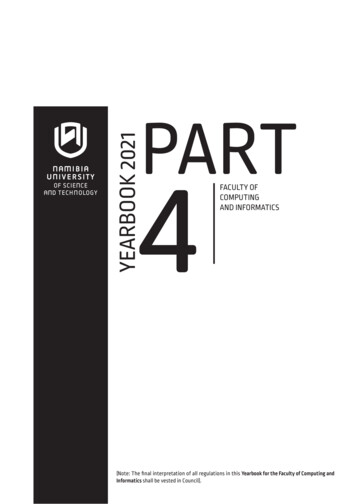
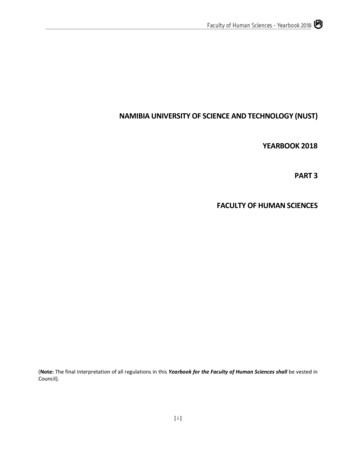

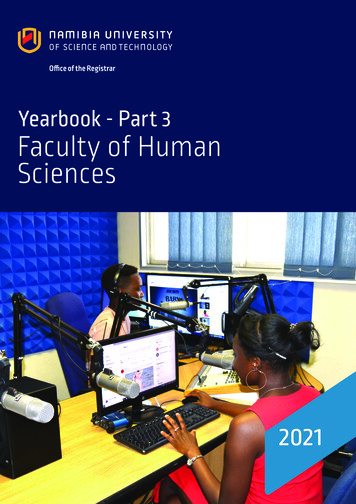

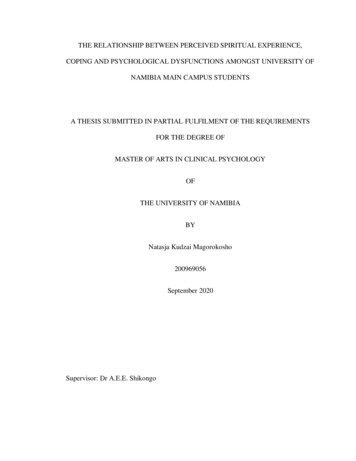
![Welcome [dashdiet.me]](/img/17/30-day-weight-loss-journal.jpg)

